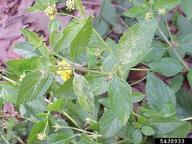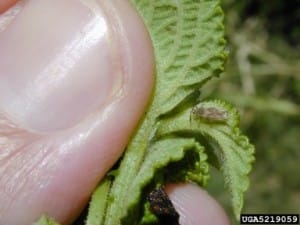Lantana Lace Bugs Can Stop Bloom!

Lantanas can bloom from June through early October in Georgia. Lantana lace bug can stop blooming in the summer leaving green plants with no blooms. The lantana lace bug is a small brown insect up to 1/6 inch long. Adult lace bugs are long, oval insects with a midsection that is slightly wider than the ends. The rear of the lantana lace bug is blunt but rounded off. The young are dull-colored and spiny. Look for the lantana lace bug by shaking the branch over a piece of white paper or light-colored cloth.
Lace bugs feed on the bottom of the leaves and on young flower buds. They make the top of the leaves speckled with white, similar to mite injury. Underneath the leaf you may see brown, tarry spots that are the insect’s droppings. Since lace bugs feed on young flower buds, lantana bloom may be severely reduced or stopped completely. When populations are very high, the lantana leaves may turn almost white and fall from the plant.
Cultural Control:
Lace bugs do have several natural enemies that help to control their numbers – spiders, lacewing larvae, assassin bugs and predaceous mites. Be careful using pesticides to preserve these natural enemies of the lantana lace bug.
Planting less susceptible varieties of lantana may help reduce lace bug numbers though this may not completely control lace bugs:
Lantana that are less susceptible to lantana lace bug:
- Weeping White, White Lightning, Weeping Lavender, Imperial Purple, Patriot Rainbow, Denholm Dwarf White, Radiation, Dallas Red, Gold Mound, New Gold and Lemon Swirl
- Cultivars of Lantana montevidensis
- Small leafed varieties seem to be less susceptible than large leafed varieties, although both types can be attacked by lantana lace bugs.

Lantana that are more susceptible to lantana lace bug:
- Patriot Desert Sunset, Pink Frolic and Patriot Sunburst
If cultural and natural controls do not limit the lace bug population, you may need to treat with chemicals.
Chemical Control:
See the UGA Pest Management Handbook for pesticide recommendations. Read and follow all label directions when using pesticides. This is especially important now since some pesticide labels have changed.
Check the plants in two weeks after the first treatment and treat again if needed. Once you control the lace bugs, the blooms should slowly return if temperatures are warm enough and other growing conditions are good.
Other problems that affect bloom:
Blooming on lantana should slow down as temperatures drop in the fall. Lantanas like full sun, well drained soils, deep watering once a week and light fertilization. If the plant is lacking one of these, correct the problem.
To improve bloom, you can prune off old seed pods or berries left from prior flowers. Then, fertilize again lightly and water deeply once a week to encourage new blooms. Take care not to over fertilize since this may reduce flowering and increase disease susceptibility.